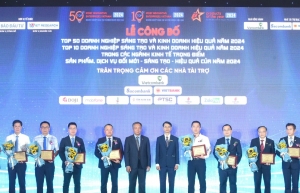Innovation and creativity serve as sustainability driving force
How many forms of innovation are there, and what is their impact on businesses?
 |
| Truong Minh Tien, CEO of Viet Research |
Innovation can be categorised into three main groups: product/service innovation, process innovation, and management and organisational innovation. In theory, each form of innovation has distinct impacts and yields different outcomes.
Within the first group, product/service innovation can help businesses increase revenue and profitability, expand their market presence, enhance customer satisfaction, and elevate their brand position.
The form of process innovation contributes to improving production capabilities, quality control of products/services, and maximising cost savings for businesses.
The third form, management and organisational innovation, impacts the effectiveness of management, long-term strategic goals, labour productivity, and overall financial performance of the business.
In the process of researching and selecting innovative and effective businesses, what factors does Viet Research rely on to measure and evaluate innovation criteria?
Innovation is qualitative criterion that can encompass various forms and approaches. Therefore, in order to objectively and comprehensively measure innovation, in addition to statistics on the number of patents, research and development projects, innovation awards, and accolades received by a business, we also consider the impact or results that stem from those innovative and creative endeavours.
Specifically, for product or service innovation, we listen to market feedback, including evaluations from consumers, regarding the level of novelty and innovation. Statistical figures such as sales revenue and profits serve as clear evidence to measure and evaluate the success of a business in implementing innovative and creative initiatives.
What is the biggest obstacle for Vietnamese businesses in the innovation process?
Limited funding and budget, lack of support from leadership, and restricted access to technology are common challenges that businesses face in the process of innovation.
However, I believe that high-quality human resources are currently a top concern for businesses in Vietnam. Despite being provided with better conditions to promote innovation, in many cases, the majority of employees tend to have a risk-averse mindset, being hesitant to embrace change and try new methods.
Businesses should create a culture that encourages experimentation, feedback, and collaboration to overcome this barrier. This means providing opportunities for testing, iteration, and continuous improvement, while also giving employees the necessary time and flexibility to explore and develop their ideas.
Leaders should also establish a culture that embraces risk-taking with an open-minded and progressive mindset, promoting collaboration and diversity. This culture should encourage employees to share and exchange ideas and perspectives across different teams, departments, and areas of expertise.
In addition to training sessions, workshops, and mentoring programmes aimed at developing a mindset for innovation, businesses should also provide appropriate recognition and rewards to incentivise their employees.
What are your recommendations on solutions to help businesses stay ahead of trends and continue to innovate?
Alongside creating an environment that fosters creativity, businesses also need to continuously monitor, supervise, and adjust to ensure that their innovation efforts stay on track.
Sometimes, implementing innovative changes may not yield immediate results, but they can help a business achieve future achievements and a new position.
Therefore, leaders should balance the short-term competitive needs with the pursuit of long-term strategies to ensure long-term survival and sustainable development.
There are three approaches that CEOs should apply to stay ahead of the innovation curve. First is cultivating a culture that places innovation at the centre. Business leaders should foster a culture that encourages experimentation, creative thinking, and a willingness to embrace change. Employees at all levels need to be empowered to contribute and share ideas, creating a foundation for cross-functional collaboration.
Secondly, to keep up with industry trends, businesses should establish and assign clear responsibilities to innovation teams. These teams can be responsible for researching emerging technologies, monitoring market changes and trends, developing partnerships within the ecosystem, and building strategies to incorporate these trends into the company’s products/services.
The third aspect is leveraging strategic partnerships. Businesses should seek collaborative relationships with startups, research organisations, or companies in the same industry to create co-innovation opportunities, enhance access to advanced research, and bring mutual benefits.
 | Event honours innovative businesses The ceremony of the Top 50 Most Innovative Enterprises Vietnam (VIE50) and the Top 10 Most Innovative Enterprises Vietnam (VIE10) was held on June 24 in Hanoi, organised by Vietnam Investment Review and Viet Research. |
 | Vietnam looking for innovation cooperation opportunities in the United States Vietnamese Minister of Planning and Investment Nguyen Chi Dung held meetings with members of the Vietnam Innovation Network and technology giants in Silicon Valley (San Francisco) during a business trip to the United States during June 22-26. |
 | Vietnam National Innovation Alliance for Pig Biosecurity launched The Australian government’s Aus4Innovation programme and the National Institute of Animal Sciences launched the National Innovation Alliance for Pig Biosecurity on June 26, introducing a mission-critical platform for enabling innovation in pig farming. |
 | Energy players look to deeper innovation to boost transition Technological innovation will help promote the energy transition in Vietnam, with the proportion of renewable capacity in Vietnam’s power system increasing rapidly. |
What the stars mean:
★ Poor ★ ★ Promising ★★★ Good ★★★★ Very good ★★★★★ Exceptional
Related Contents
Latest News
More News
- Businesses ramp up production as year-end orders surge (December 30, 2025 | 10:05)
- Vietjet chairwoman awarded Labour Hero title (December 29, 2025 | 13:06)
- How to unlock ESG value through green innovation (December 29, 2025 | 10:03)
- AI reshapes media and advertising industry (December 29, 2025 | 08:33)
- FPT and GELEX sign deal to develop blockchain tech for global markets (December 29, 2025 | 08:29)
- Vietnam’s GDP forecast to grow by 9 per cent in 2026 (December 29, 2025 | 08:29)
- Women entrepreneurs are key to Vietnam’s economic growth (December 29, 2025 | 08:00)
- Vietnam's top 500 value-creating enterprises announced (December 27, 2025 | 08:00)
- The PAN Group shaping a better future with ESG strategy (December 26, 2025 | 09:00)
- Masan Consumer officially lists on HSX, marking the next phase of value creation (December 25, 2025 | 13:20)

 Tag:
Tag:




















 Mobile Version
Mobile Version